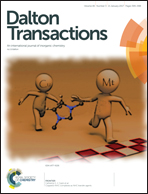Half-sandwich complexes of iridium and ruthenium containing cysteine-derived ligands†
Abstract
The dimers [{(ηn-ring)MCl}2(μ-Cl)2] ((ηn-ring)M = (η5-C5Me5)Ir, (η6-p-MeC6H4iPr)Ru) react with the modified cysteines S-benzyl-L-cysteine (HL1) or S-benzyl-α-methyl-L-cysteine (HL2) affording cationic complexes of the formula [(ηn-ring)MCl(κ2N,S-HL)]Cl (1, 2) in good yield. Addition of NaHCO3 to complexes 1 and 2 gave equilibrium mixtures of neutral [(ηn-ring)MCl(κ2N,O-L)] (3, 4) and cationic [(ηn-ring)M(κ3N,O,S-L)]Cl (6Cl, 7Cl) complexes. Similar mixtures were obtained in one-pot reaction by successive addition of the modified cysteine and NaHCO3 to the above formulated dimers. Addition of the N-Boc substituted cysteine derivative S-benzyl-N-Boc-L-cysteine (HL3) and NaHCO3 to the dimers [{(ηn-ring)MCl}2(μ-Cl)2] affords the neutral compounds [(ηn-ring)MCl(κ2O,S-L3)] ((ηn-ring)M = (η5-C5Me5)Ir (5a), (η6-p-MeC6H4iPr)Ru (5b)). Complexes of the formula [(ηn-ring)MCl(κ3N,O,S-L)][SbF6] (6Sb–8Sb), in which the cysteine derivative acts as a tridentate chelate ligand, can be prepared by adding one equivalent of AgSbF6 to the solutions of compounds 5 or to the mixtures of complexes 3/6Cl and 4/7Cl. The amide proton of compounds 8aSb and 8bSb can be removed by addition of NaHCO3 affording the neutral complexes [(ηn-ring)M(κ3N,O,S-L3-H)] ((ηn-ring)M = (η5-C5Me5)Ir (9a), (η6-p-MeC6H4iPr)Ru (9b)). Complexes 9a and 9b can also be prepared by reacting the dimers [{(ηn-ring)MCl}2(μ-Cl)2] with HL3 and two equivalents of NaHCO3. The absolute configuration of the complexes has been established by spectroscopic and diffractometric means including the crystal structure determination of (RIr,RC,RS)-[(η5-C5Me5)Ir(κ3N,O,S-L1)][SbF6] (6aSb). The thermodynamic parameters associated with the epimerization at sulphur that the iridium compound [(η5-C5Me5)Ir(κ3N,O,S-L3-H)] (9a) undergoes have been determined through variable temperature 1H NMR studies.



 Please wait while we load your content...
Please wait while we load your content...